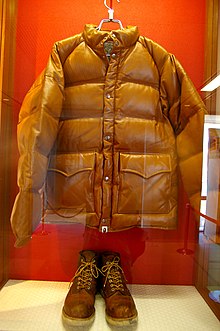Down coat
A down jacket or a down coat is a piece of clothing ( jacket or coat ) that is very warm and yet breathable and very light thanks to a filling with down .
The insulating effect of the garment is defined by the fill power of the down. It amounts to 600–700 cuin for high-quality products, which are characterized above all by neatly processed seams , but also by a high quality of down. Down-proof material is used for the outer and inner fabric so that the down does not get through the fabric. Polyamide fabrics are mainly used, which are very light and water-repellent. Cold bridges through the seams are eliminated by the box-chamber construction. The down is worked into the chambers. New down has a longer lifespan than additives from recycled old down beds.
criticism
Like all other down products, down jackets and coats are criticized by animal welfare organizations insofar as the down is obtained under conditions that are difficult for the animals, for example by plucking the feathers from the geese while they are still alive so that one goose down several times can win. This so-called live plucking is prohibited by law in Germany.
In addition, the insulating performance of down clothing deteriorates when it gets wet.
Web links
Individual evidence
- ↑ Gabi Greiner: Warm, light - but also good? Austrian Broadcasting Corporation, Public Law Foundation, November 23, 2011, accessed on November 16, 2014 .
- ↑ Do without down. Peta, accessed November 16, 2014 .
- ↑ STANDING COMMITTEE OF THE EUROPEAN CONVENTION FOR THE PROTECTION OF ANIMALS IN AGRICULTURAL RISKING OF ANIMALS (T-AP) RECOMMENDATION WITH REGARD TO DOMESTIC GEESE (ANSER ANSER F. DOMESTICUS, ANSER CYGNOIDES F. DOMESTICUS). Federal Ministry of Food and Agriculture, accessed on July 11, 2019 .
- ↑ Animal welfare for water fowl. In: German Bundestag - Drucksache 18/4251. March 4, 2015, accessed July 11, 2019 .
